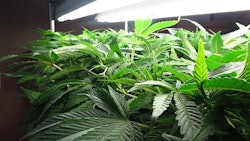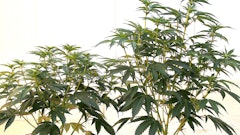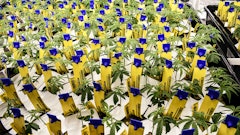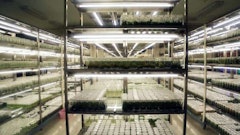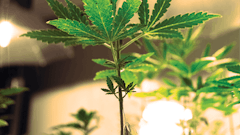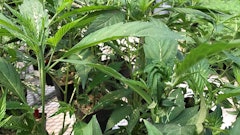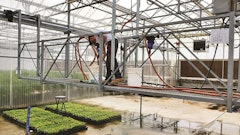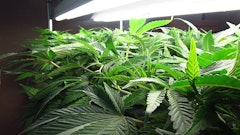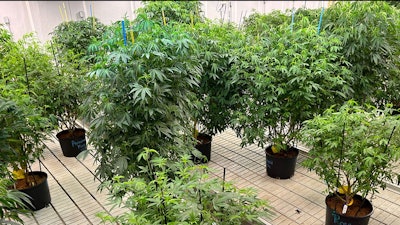
For many cannabis cultivators, the mother room is the heart of the company.
Dialing in environmental control, irrigation, nutrients and pest management in propagation, veg and flower is key for indoor and greenhouse cannabis cultivators, as managing growth, plant health and flower development in the three stages is crucial to producing successful products. Postharvest practices like drying and curing are other processes that must be carefully managed.
But until plants make their way through the production cycle, they are cared for in mother rooms, typically smaller areas of grows but arguably the most important space in many operations, where genetics are maintained, preserved and strategically pruned to produce the strongest, healthiest clones possible and a new generation of crops.
Two cultivation directors managing indoor cannabis grow facilities in Ohio welcomed Cannabis Business Times to explore their operations and offered guidance and best practices for mother room management based on years of fine-tuning. Here, Christine DeJesus, cultivation director at Galenas, and Mike Lentz, cultivation and processing director at Klutch Cannabis, offer advice and key care tips for mother plants. CBT also consulted with Zamir Punja, Ph.D., professor of plant pathology and biotechnology at Simon Fraser University, who shares his latest research on how to protect mother plants and prevent pathogens from spreading, especially hop latent viroid (HpLVd).
1. Keep the number of employees working in the mother room to a minimum.
One of the most crucial aspects of managing a successful cannabis cultivation facility is cleanliness and sanitation. And one of the most important spaces in that effort is the mother room, as healthy mother stock leads to healthy clones, which establishes a strong foundation at the start of the grow cycle.
“We have some pretty tight, strict protocols in here,” says DeJesus, standing in the mother room at Galenas’ Akron, Ohio, grow facility, which operates 4,600 square feet of canopy. “Try and isolate employee movement so that generally the only people working in the mother rooms are the people that are in charge of those rooms.”
Basic sanitation practices in other areas of the grow apply to the mother room as well—and DeJesus suggests ensuring employees wear gloves (and change them between plants) and keep dedicated clothes and shoes only worn at the grow.
2. Assign a pruning shear to each mother plant as an extra precaution, especially against HpLVd.
With about 60 mother plants, keeping individual pruning shears for each mother can be an investment, but one well worth it to Galenas to prevent outbreaks and ensure if there is a pest or pathogen that develops, that it is isolated to as few plants as possible.
Research from Simon Fraser University shows that one of the most concerning diseases, hop latent viroid (HpLVd) can survive on surfaces, and a solution of at least 10% bleach is required to properly sanitize tables and pots, says Punja.
“But for hands and tools, it’s too strong,” he says. “It will do a pretty good job and a lot of websites will tell you 10% bleach, but it’s hard to work with.” (Learn more about preventing HpLVd in Tip 11, below.)
3. Rotate out mother plants every three to six months.
Most mother plants at Galenas are kept for 100 days or less, and at Klutch Cannabis, the team makes sure it gets new moms every four to six months.
“As plants age, they definitely become more susceptible to disease,” DeJesus says. “Every year, we go through and delete some of our library so that we can maintain the health of everything. We have a set of plants primarily in this room right now that are our library, and then we have another set of plants that are for production. We must maintain a separate library of plants that are just placeholders that aren't into production this cycle but might be somewhere later.
“What happens as a plant ages is that it lignifies. So, this plant's getting a little old, and you can see the stems are starting to get more woody,” DeJesus says, running her hands along the stems of one of the older mother plants. “And so those types of stems don't root as well as plants that are soft and green like these. This is still nice and soft and supple and green, and it'll root faster.”
Plus, older stems can rot before they root, DeJesus says.
Punja echoes this sentiment, and says fusarium is one of the most common diseases that develops in older mother plants. Because of this, he suggests keeping mother stock no longer than four months.

Galenas houses about 60 cultivars in its two-tier mother room, keeping plants in 4- to 7-gallon containers to give plants enough space and promote good airflow. Photo: Michelle Simakis
4. Keep mother plants in medium-sized pots with good spacing and airflow.
Since DeJesus started at Galenas in 2019, she and her team have been fine-tuning production, and one big change they made was moving mothers from 10- to 20-gallon pots, in some cases, down to 4- to 7-gallon containers filled with living soil, which works well in their two-tier mother room.
“My mom and prop lead, Jimmy Riley, calls them ‘teenagers’—we find that the teenager-size plants seem to give us the highest quality clones,” DeJesus says. “If the plants are too big and too old, then the rooting takes a bit longer. If they're too small, you don't get enough clones off them. But somewhere in that mid-range is where we found the best of both worlds.”
Klutch also keeps its mature mothers in 7-gallon containers using coconut coir as a media, finding that size to be the sweet spot when it comes to mitigating pathogen risk and irrigation management in the root zone, Lentz says. “There are many variables to consider when managing a mother, but for us and our mature moms, I like to give them 25 square feet to let that plant have the space it needs to grow efficiently. This can change based on maturity.”
5. Consider node spacing in plant morphology.
Placing younger mother plants in smaller containers also helps to maintain ideal node spacing of about 3 inches, DeJesus says.
“Sometimes when plants age or the plants reach the lights, you'll find that your node spacing can shrink here and there. So then when you cut this clone, the nodes will be too close together and the branching won't be ideal,” DeJesus says. “They'll kind of shade each other. It's important to keep a healthy node space.”
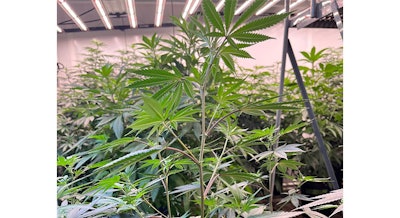
Christine DeJesus, cultivation director at Galenas, says smaller mother plants help them achieve ideal node spacing of about 3 inches. Photo: Michelle Simakis
6. Establish clear pruning, shaping and topping protocols.
Managing a mother canopy is much different from a flowering canopy Lentz says, and it’s important that the team understands that.
“I leave a lot of the lower biomass on the plant and continuously shape the plant from the top and lightly prune from the bottom, making sure we have enough lower biomass to help reshape a mother after a cloning event. If you prune your undergrowth, after a couple of cloning events, you're going to have a really tall, palm-tree-like plant that is difficult to work with,” he says. “Shape them and keep them short and wide. Understand how to not prune too much, and shape the plant at the right time to get extra healthy, fresh biomass to work with for your next cloning event.”
Giving moms a break after a cloning/reshaping is also important, and Lentz says they typically allow two to three weeks in between scheduled cloning events, while continuously shaping the plant in-between events. “Encourage the team members to always consider what they do to the plant today and how it will impact the plant in the weeks to come, which involves paying attention to the morphology of the different cultivars, in terms of plant growth,” Lentz says.
DeJesus takes a similar approach at Galenas.
“You have to top it a few times to get some of these smaller side branches to grow out because it's apically dominant –[cannabis] really wants to go just straight up and not push out,” DeJesus says. “And so, what happens is then you're not going to get that many clones off of a plant like that unless you start to top it and prune it so that you get more side branching.”
7. Map out your mother room capacity to stay on pace with the garden schedule.
For Lentz, one of the most important aspects of managing a mother room is keeping pace with production at Klutch Cannabis. Each week, the team takes over 3,000 cuts. In December, he had already mapped out production through 2024—a necessity when managing two veg rooms, 14 flower rooms, and cultivating roughly 60 cultivars at a time.
“When planning mom inventory and capacity, it’s important to understand the cultivation infrastructure, quantity of flower rooms, canopy size, plant density, crop rotation, and how many cultivars are in production. Production goals should also be considered when managing mom stock,” Lentz says. “All cultivars have different attributes, so it’s important to document historical data to understand growth patterns and clone output for each of your genetics. Using all of these metrics can help a cultivator make educated decisions when it comes to production planning.”
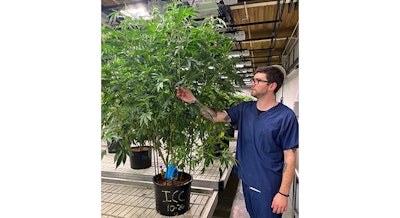
Mike Lentz, cultivation and processing director, describes the pruning and topping strategy at in one of two mother rooms at Klutch Cannabis. Photo: Michelle Simakis
8. Adjust the environment based on your production goals.
Both DeJesus and Lentz recommended easy-going light levels in mother rooms, with a photosynthetic photon flux density (PPFD) at 400 to 600 micromoles per square meter per second (μmol/m2/s). Both Ohio growers also preferred a day/night schedule (18 hours day/six hours night) in mother rooms.
“Some grows like to run their lights at 24 hours for their mothers, but I'm a supporter of having the balance of the light and dark cycle, not only for the plants, but also for the microbes in the soil, which have light and dark cycles, as well,” says DeJesus, who operates LEDs in two tiers in the mother room and keeps PPFD to 500 μmol/m2/s max.
Lentz at Klutch has a similar philosophy, but parameters can and do change.
“There're many tools in the cultivation toolbox that can be used to manipulate growth. For example, vapor pressure deficit [VPD], daily light integral [DLI], CO2 enrichment, and differentials can all be used to slow down or speed up plant growth and to tighten or increase internodal spacing.”
In general, Lentz says, “in the mother room, we like it hot and humid with targets that can range between a VPD of 1 to 1.2 kPa, DLI of 25 to 40, and CO2 at 400 to 800 ppm. Making subtle changes to your control points will encourage different growth responses.”
Although Klutch automates irrigation and fertigation in veg and flower, all mother plants are hand-watered to make sure they get the appropriate dry back.
“Overwatering can be a big issue, especially when you're dealing with many different sized/aged mother plants,” Lentz says. “We give each mom its own special attention. For example, when you have a fully mature mother plant, and you cut out three-fourths of its biomass for clones, the plant’s water requirements can change, and you may want to back off watering events. Spot-watering mother plants can give you the ability to manage irrigation to enhance the plant’s performance and help mitigate rootzone pathogens.”
At Galenas, DeJesus finds that hand watering every three days, or about twice a week, helps optimize plant growth, development and health.
“We've experimented with giving the plants less water more frequently and giving the plants more water less frequently. I bring my gardening and my home house plant mindset with mother plant maintenance in the sense that I like to water my plants deeply and then let them dry back before watering again,” DeJesus says, adding the caveat that it might not work best for every grow. “If you water more frequently and in lesser amounts, lots of times you have more issues with soilborne pests like fungus gnats. You can get root diseases, rot and things like that from just having too much moisture for too long within the soil.”
10. Scout the mother room daily for pests and diseases.
Growers working in any environment, but particularly indoors, need to regularly and carefully monitor all plants for pests and diseases.
At Galenas, there is one person who is a dedicated scout and oversees the integrated pest management (IPM) program, which includes daily checks of all mother room plants.
RELATED: 6 Pest Scouting Tips for Indoor Grows
“We use two different predator mites that live on the foliage,” DeJesus says. “One is kind of a generalist, and so it's a predator that'll eat a lot of different pests like spider mites. Thrips, spider mites and fungus gnats are generally most problematic in a mom room.
“In indoor environments, once a pest or disease gets in there, you can have a lot of problems fast because they like it in there and they can multiply out because they're in a very good environment for their growth cycles.”
11. Take steps to prevent and mitigate hop latent viroid (HpLVd).
Most commercial cannabis growers have hop latent viroid on their radar and are taking steps to prevent it. For Galenas, in-house breeding and assigning individual shears for each mother plant have protected the facility from the devastating disease that can cause stunted growth, smaller leaves, smaller internodes, smaller flowers and reduced yields.
Unfortunately, these symptoms aren’t often apparent until plants start to flower, says Zamir Punja, Ph.D., of Simon Fraser University. University research has found HpLVd can live on many surfaces and spreads easily, through water and shared irrigation and fertigation lines, from mother plants into cuttings, from stems into roots and from roots into the plant, creating systemic infection. To further complicate diagnosis, some cultivars are more susceptible than others, and sometimes the disease will live in only a portion of the plant, meaning one test is not enough to confirm a plant is free of HpLVd.
RELATED: How to Spot, Mitigate and Prevent HpLVd in Cannabis Cultivation
Punja says the most common way HpLVd enters a facility is through external plants or cuttings. So quarantining is crucial, and so is keeping the plant in quarantine until diagnostic tests are complete.
And he echoes Lentz’s recommendation to give mother plants space and keep them physically separate from each other.
It’s also important to test mother plants regularly before using them for clones and on different areas of the plant, Punja says. In general he advises growers to test three samples from the plant each time, and to test three times, with each test occurring two weeks apart. If all tests are negative for HpLVd, they can then be used for production.
Most labs use polymerase chain reaction (PCR) technology, and there is also technology available if growers want to run the tests in-house, Punja says.
Right now, Punja says he is focusing on research to determine which cultivars are most susceptible to HpLVd and which are most resistant.
“That’s the way forward, to really understand why some plants get it and why some don’t,” Punja says. “I think breeding is the way to go. Breeding for resistance, whether it’s hop latent or powdery mildew or botrytis, is definitely going to be the way of the future.”












